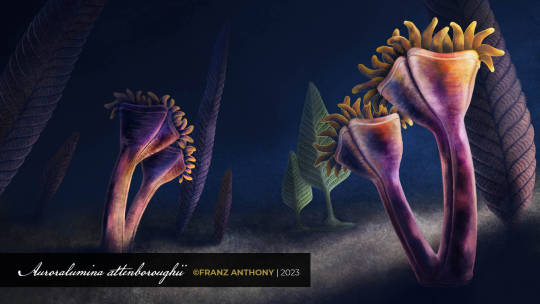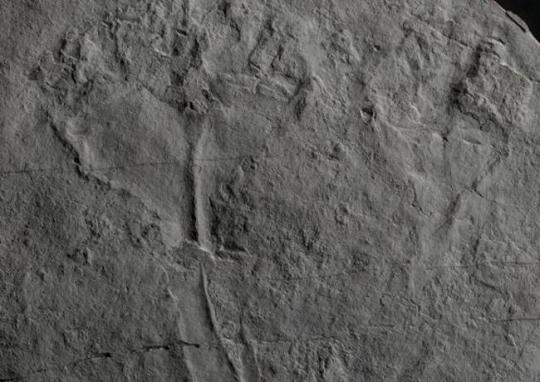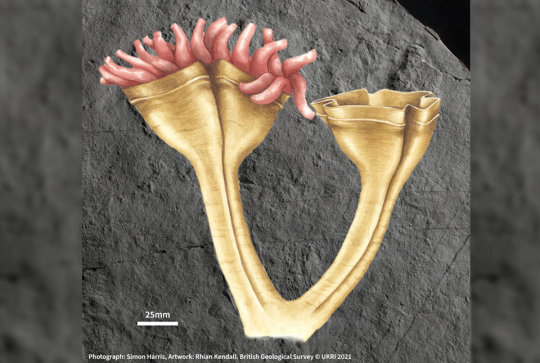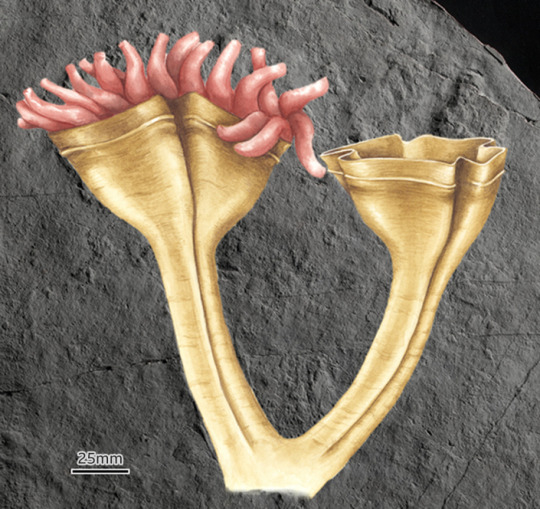#auroralumina attenboroughii
Text

i spent WAY too much time making this drawing for a silly prehistoric creature version of this meme XD
Auroralumina attenboroughii is the earliest known animal predator as of right now, and its believed to have eaten little plankton-like creatures!
Hope you enjoy this silly drawing, and have an AWESOME day!!
#auroralumina attenboroughii#auroralumina#prehistoric#paleoart#paleo meme#ediacaran#i didn't even know this creature existed until i had the idea to do this meme with the first animal to have to kill other animals XD#i was expecting to draw a goofy cambrian animal like anomalocaris but instead i found this cool tube-y anemone-y thing!#it took so long to draw mainly because i really wanted to make it look like cool paleo-art - usually i draw very cartoony
314 notes
·
View notes
Photo

Cnidarians – a group of animals that includes modern corals, sea anemones, sea pens, jellyfish, hydra, and a couple of parasitic forms – are one of the most ancient animal lineages, originating at least 580 million years ago in the Ediacaran period.
Actual identifiable fossils of cnidarians that old are incredibly rare, however, and until now there was only one example – the small polyp-like Haootia from Canada.
But a second definite Ediacaran cnidarian has now been described: Auroralumina attenboroughii.
It was discovered in Charnwood Forest, England, in the very same site where the first recognized Precambrian fossils were found in the 1950s. About 20cm tall (~8") it dates to around 560 million years ago and was made up of a pair of forking stiff-walled tubes which expanded into wide four-sided goblet-like shapes full of stubby tentacles. These densely-tentacled crowns would have been used to capture tiny planktonic organisms from the water around it, making it the current earliest known example of a predatory animal.
The one known fossil specimen has an incomplete base, so it's uncertain if this was actually the full life appearance of Auroralumina or if it was even larger with more branches and goblets. And although it was preserved in deep-water sediments, it appears to have originated from much shallower waters, being swept down into the depths during a volcanic eruption.
While it superficially resembled a sea anemone, details of its anatomy suggest it was actually much closer related to medusozoans, having similar traits to the immobile polyp stage of the jellyfish life cycle. Its four-way symmetry and boxy shape may also link it to the enigmatic conulariids.
It's not clear if it was able to bud off swimming medusa stages like its modern relatives – that might be an evolutionary innovation that came along later – but it at least shows that a basic medusozoan body plan was already in place around 20 million years earlier than previously thought.
———
Nix Illustration | Tumblr | Twitter | Patreon
#science illustration#paleontology#paleoart#palaeoblr#auroralumina#medusozoa#cnidaria#invertebrate#ediacaran#art
254 notes
·
View notes
Text

Auroralumina attenboroughii
A 560 million years old goblet-shaped organism interpreted as a cnidarian—relative of jellyfishes and sea anemones.
The species is named after David Attenborough, who studied near where the fossil was found in Leicestershire.
83 notes
·
View notes
Text
A hundred years from now, Sir David Attenborough’s body may have turned to dust, but a fossilised sea creature, thought to represent Earth’s earliest animal predator, will continue to bear his name.
Discovered in Charnwood Forest, Leicestershire, where Attenborough hunted for fossils as a child, the creature predates what was previously thought to be the oldest predator by 20m years.
Palaeontologists have named it Auroralumina attenboroughii, in honour of the TV presenter. The first part of its name is Latin for dawn lantern, in recognition of its great age and resemblance to a burning torch, and the creature is thought to have used a set of densely packed tentacles to capture food in Earth’s early oceans.
#fossils#explore#dinos#dinosaurs#time#prehistoric#science#david attenborough#life#earth#discovered#sciencenature#science daily#latest science news sciencedaily
32 notes
·
View notes
Text
sometimes i remember that the first animals was not, in fact, a jellyfish, but a silly little sea sponge
but then I remember that the first (animal) predator- the Auroralumina attenboroughii is a part of the subphylum Medusozoa which means that IT WAS A JELLYFISH AND I AM SHAKING :)

like, you go girlie! :) Slay ^-^
#this is NEW research btw#like#the summer of this year new#god#gosh#golly#like on first appearance it LOOKS like a coral from anthozoa#but apparently it's not!!#tbh it looks like a staurozoa or something from hydrozoa to me but a win is a win!!!#mun rambles#jellyfish
6 notes
·
View notes
Text
... and fill the earth (2)
Dear Caroline:
This morning I finished Yglesias' book about the 1 billion Americans which you had recommended in your blog. I was actually a bit surprised that it was over - I was finishing my daily 50 minutes in the treadmill and the e-book still seemed to have 150+ pages left, but I quickly discovered they were just very badly spaced notes and bibliographical references.
I must say I found the argument pretty compelling, and assuming bona fide that the data employed is correct, it seems as the way to go. It has gone quite a long way to dispelling some of my parochial, zero-sum prejudices on population increase, even if I still retain some lingering doubts on minor aspects and details. But the whole thesis and the exposition feel quite reasonable in both of the senses of 'common sensical' and 'employing reason to analyze problems and propose solutions'.
My next take in the 'Carolingian series' will be Joseph Heinrich's The Weirdest People in the World, of which besides your review, you also talk about briefly in the second FTX podcast. I'll be giving it a go in late February / March and let you know here what I thought about it.
Right now, I am under a considerable mountain of paper. Besides our language school book club, I have joined an online EA one (this month's take is Judea Pearl's The Book of Why) and will be trying to keep up too with an asynchronous virtual book club for Eugenia Cheng's The Joy of Abstraction, about Category Theory. They both look really interesting. And finally, I filled in an application for joining EA's The Precipice Reading Group which, if admitted, is scheduled from March to May.
Talking about 'filling the earth', today I watched a PBS Eons video that blew my mind. It was about Pre-Cambrian fossils of creatures that apparently flourished in the Ediacaran Period. I imagine you might like it as well. I am definitely going to look for (yet another) book that delves into this in greater detail...
Quote:
Here, we describe a new fossil cnidarian—Auroralumina attenboroughii gen. et sp. nov.—from the Ediacaran of Charnwood Forest (557–562 million years ago) that shows two bifurcating polyps enclosed in a rigid, polyhedral, organic skeleton with evidence of simple, densely packed tentacles.
F.S. Dunn el al., extract from (the abstract of) the article on this topic, in February's issue of Nature
0 notes
Text
Un fósil de 560 millones de años es el primer animal depredador
Un fósil de 560 millones de años es el primer animal depredador
Geólogos han encontrado el fósil del depredador animal más antiguo conocido. Con 560 millones de años, está relacionado con el grupo que incluye corales, medusas y anémonas que viven en el planeta hoy.
Los paleontólogos que la descubrieron la han llamado ‘Auroralumina attenboroughii’ en honor a Sir David Attenborough. La primera parte de su nombre en latín significa “linterna del amanecer“, en…

View On WordPress
0 notes
Text
El extraordinario hallazgo del fósil del depredador más antiguo que se conoce
El extraordinario hallazgo del fósil del depredador más antiguo que se conoce
Es el depredador animal más antiguo conocido y tiene 560 millones de años.
Científicos de Reino Unido lo encontraron hace años en Charnwood Forest, en Leicestershire, y han identificado ahora su fósil por primera vez.
Lo han llamado Auroralumina attenboroughii, en honor al biólogo David Attenborough, y creen que es un precursor de los cnidarios, el grupo de especies que hoy incluye a las…

View On WordPress
0 notes
Link
0 notes
Text
Un fossile di 560 milioni di anni fa è il primo predatore animale conosciuto
Un fossile di 560 milioni di anni fa è il primo predatore animale conosciuto
Impressione d’artista del nuovo fossile.
I geologi hanno trovato il fossile del primo predatore animale conosciuto. L’esemplare, risalente a 560 milioni di anni fa, è il primo del suo genere, ma è imparentato con il gruppo che comprende coralli, meduse e anemoni che vivono oggi sul pianeta.
I paleontologi che lo hanno scoperto lo hanno chiamato Auroralumina attenboroughii in onore di Sir David…

View On WordPress
0 notes
Text
‘Earliest animal predator’ named after David Attenborough
‘Earliest animal predator’ named after David Attenborough
LONDON — A fossil of a 560-million-year-old creature, which researchers believe to be the first animal predator, has been named after the British naturalist and broadcaster David Attenborough.
Scientists said Monday they believe the specimen, named Auroralumina attenboroughii, is the earliest creature known to have a skeleton. It is related to the group that includes corals, jellyfish and…

View On WordPress
0 notes
Text
Ehre für berühmten Naturfilmer: Forscher benennen Räuber-Fossil nach Attenborough
Ehre für berühmten Naturfilmer: Forscher benennen Räuber-Fossil nach Attenborough
Forscher entdecken bei Ausgrabungen ein 560 Millionen Jahre altes Räuber-Fossil. Auroralumina attenboroughii, so taufen sie ihre Neuentdeckung – zu Ehren des Naturfilmers David Attenborough. Der Brite ist sichtlich begeistert.
Weiterlesen…

View On WordPress
0 notes
Text
Ancient fossil is earliest known animal predator
Ancient fossil is earliest known animal predator
Auroralumina attenboroughii
A fossil representing the earliest known animal predator has been identified by UK scientists.
The 560-million-year-old specimen, which was found in Charnwood Forest in Leicestershire, is likely a forerunner of cnidaria – the group of species that today includes jellyfish.
The researchers have named it Auroralumina attenboroughii in honour of Sir David…

View On WordPress
0 notes
Text
Fossil of 'first animal predator' named after Sir David Attenborough
Fossil of ‘first animal predator’ named after Sir David Attenborough
Palaeontologists are naming the fossil Auroralumina attenboroughii in honour of the 96-year-old broadcaster and natural historian. Its name is Latin for “dawn lantern” in reference to its age and resemblance to a burning torch.
A fossil of the earliest known animal predator has been named after Sir David Attenborough by the geologists who discovered it.
The 560-million-year-old creature is the…

View On WordPress
0 notes